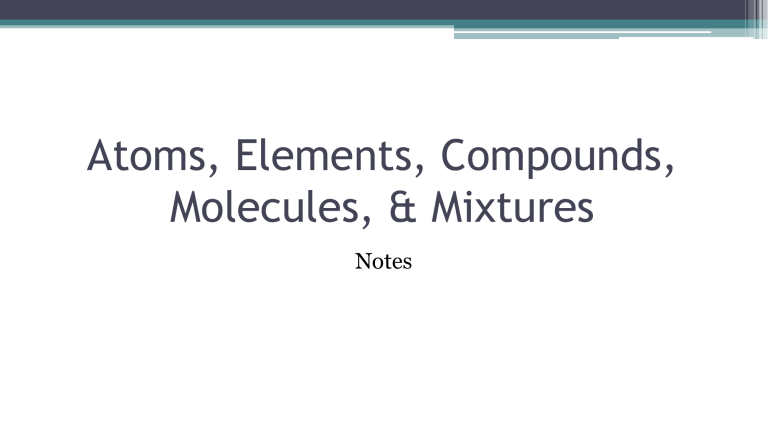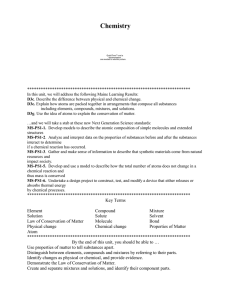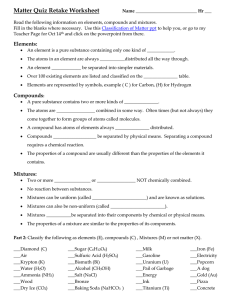
Atoms, Elements, Compounds, Molecules, & Mixtures Notes Activating Strategy Let’s See What you Know… In our previous lesson we learned that the pencil is matter made of ______? If you look closely at the tip of a sharpened pencil, you will see that it is made of a specific type of matter called graphite. The image shows a close up picture of the graphite. The graphite is made up of even smaller particles called atoms _____. These particles contain even smaller particles called protons, neutrons, electrons _____________________ How are atoms, molecules, elements, compounds, & mixtures related? Standard: S8P1a. Distinguish between atoms and molecules, as well as pure substances (elements and compounds) and mixtures Adapted from www.middleschoolscience.com 2008 How is matter classified? Matter Pure Substance Element Mixture Compound Matter is anything that has mass and takes up space (volume) There are different types of Matter: Pure Substances (elements and compounds) and Mixtures The composition (structure) of a substance determines its Matter type. Characteristics of Pure Substances • Fixed composition • Distinct properties • Cannot be separated into simpler substances by physical methods • Can only be changed in identity and properties by chemical methods • Properties do not vary one sample to another sample • Types of Pure Substances: Elements & Compounds Image are from http://www.chem4kids.com •A small particle that makes up Matter •Consists of Protons (+), Electrons (-), and Neutrons (N) How big is an atom? www.scaleofuniverse.com • Consists of only one kind of atom. • Cannot be broken down into a simpler type of matter. •Examples: Gold, Helium, Hydrogen, Uranium, Lithium • A molecule consists of two or more atoms of the same element, or different elements, that are chemically bound together. • In the animation above, two nitrogen atoms (N + N = N2) make one Nitrogen molecule . Compounds • Form when two or more different elements join (bond) together chemically • Composition is identical in each sample • Can be separated only by chemical methods • Properties of a compound are totally different than the properties of the elements that form them • Examples: Water, Carbon dioxide, Salt Animated images and notes from http://www.chem.purdue.edu/gchelp/atoms/elements.html Cl Na Compounds What’s the difference between a molecule and a compound? Watch the video! https://www.youtube.com/watch?v=0gsrW0Vb5sw A molecule is formed when two or more atoms join together chemically. A compound is a molecule that contains at least two different elements. All compounds are molecules but not all molecules are compounds. Elements and Compounds Study Jams Video http://studyjams.scholastic.com/studyjams/jams/sc ience/matter/elements-and-compounds.htm Mixtures • Form when elements and/or compounds are combined physically • Properties of a mixture are related to its components • Composition varies from sample to sample • Can be separated by physical methods • Examples of Mixtures: Tea, Perfume, Air, Salad, Beach sand, oil and vinegar salad dressing, etc. Mixtures Mixture of Different Elements Mixture of Different Compounds Mixtures Mixtures are often referred to as homogeneous or heterogeneous. Mixtures • Homogeneous mixtures (Solutions) have a uniform distribution. • For example: Tea, Perfume, Air Mixtures • Heterogeneous mixtures do not have a uniform distribution. • Parts are often visible • For example: Salad, Beach Sand, Oil and Vinegar dressing Mixtures Study Jams Video http://studyjams.scholastic.com/studyja ms/jams/science/matter/mixtures.htm Distinguishing between Elements, Compounds, and Mixtures Distributed Summarizing The diagram below shows how two elements can be mixed together…Which is a Compound? A Mixture? C. A. B. D. Match the Picture to the Description Compound of 2 Elements Mixture of Molecules Element Molecule Compound of 3 Elements Element/ Atoms Mixture of Atoms Match the Picture to the Description Compound of 2 Elements Mixture of Molecules Element Molecule Compound of 3 Elements Element/ Atoms Mixture of Atoms A Chemical Formula is a representation of a substance using symbols for its essential elements. Counting elements in a molecule • Count the number of different capital letters or element symbols in the compound. © KeslerScience.com A Chemical Formula represents in symbols and numbers the amount of atoms in a specific type of matter. Let’s examine a few Chemical Formulas. H2O = Water How many atoms are there in H2O? How many elements? There are 2 elements (Hydrogen & Oxygen). There are 2 Hydrogen Atoms and 1 Oxygen Atom A Chemical Equation is a symbolic representation of what happens when atoms react with each other Review: What is the Law of Conservation of Matter? The Law of Conservation of Matter [Mass] states that matter cannot be created or destroyed. It changes form. A Chemical Equation can illustrate the Law of Conservation of Matter. Let’s see how Law of Conservation of Matter [Mass]: The Mass of the Reactants is EQUAL to the Mass of the Products Law of Conservation of Matter [Mass] © KeslerScience.com Quick Action – Elements and Compounds 1. Complete the chart by counting the elements and naming them. 2. Record your answers in the chart located in your notes. Formula H2O NaCl C6H12O6 NaOH # of different elements Name of elements © KeslerScience.com Quick Action – Complete & Turn it in! 1. Cut out the INB template and glue along the narrow tab. 2. Looking at the formula, decide if it is a compound or an element. 3. Name each element in the formula.





